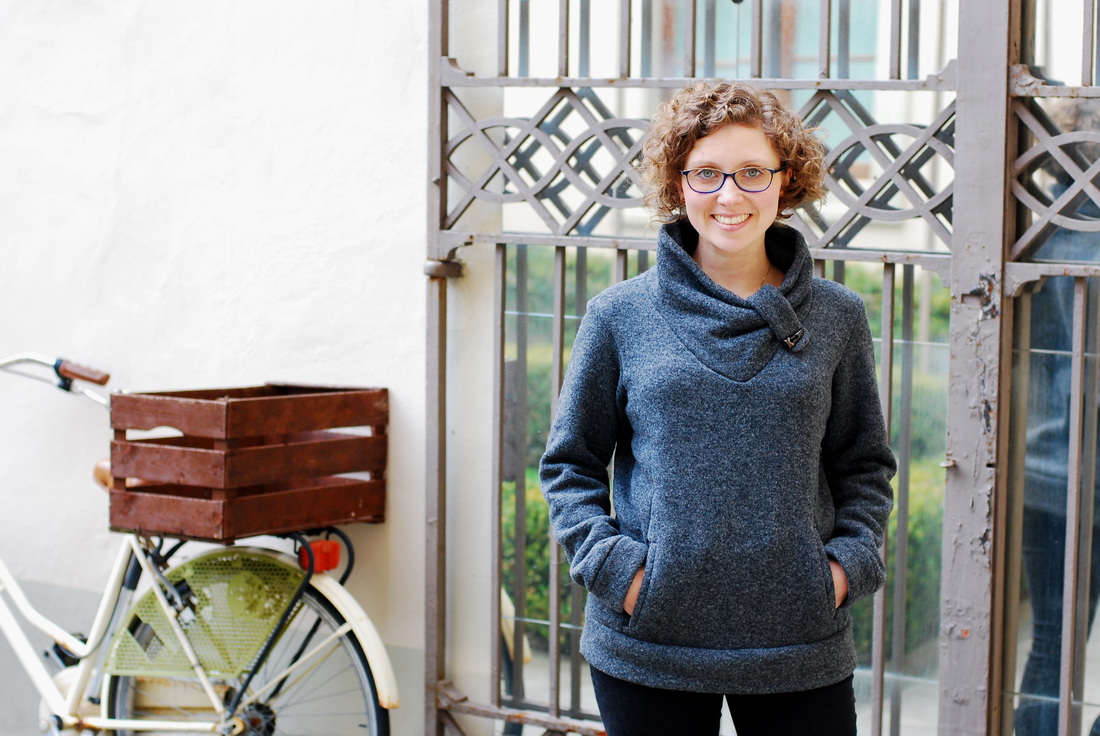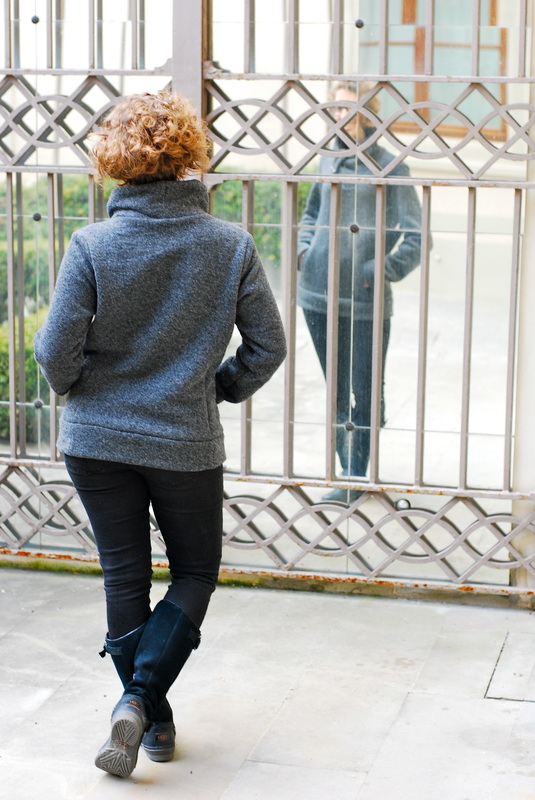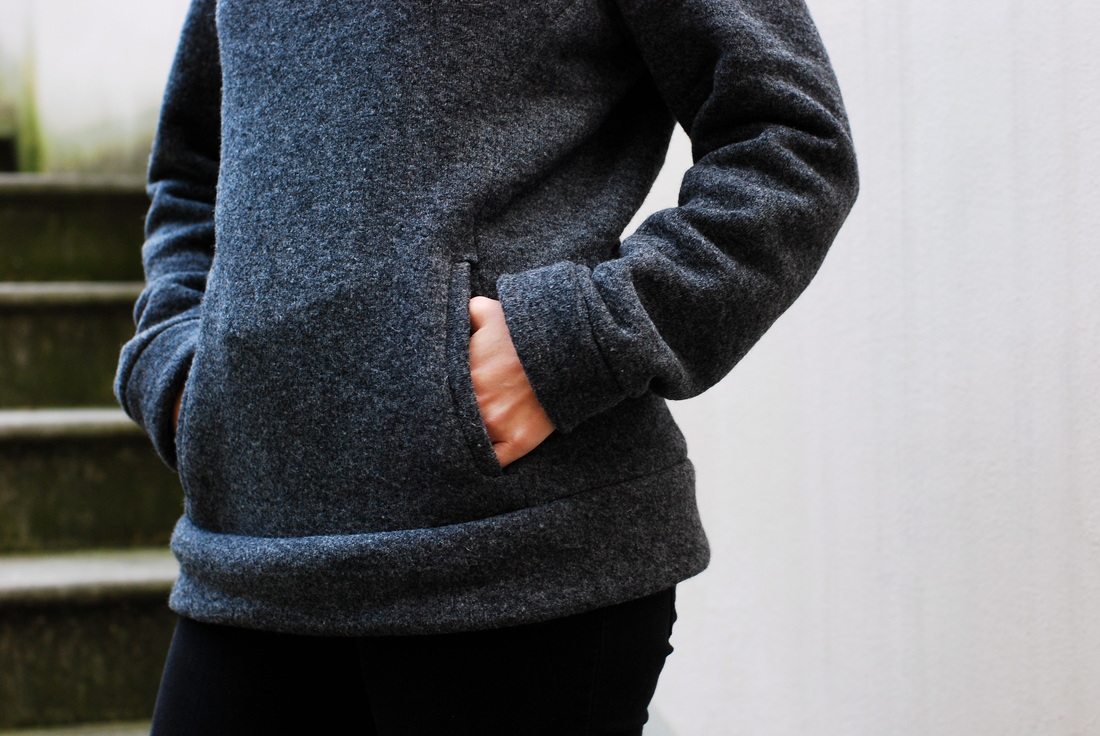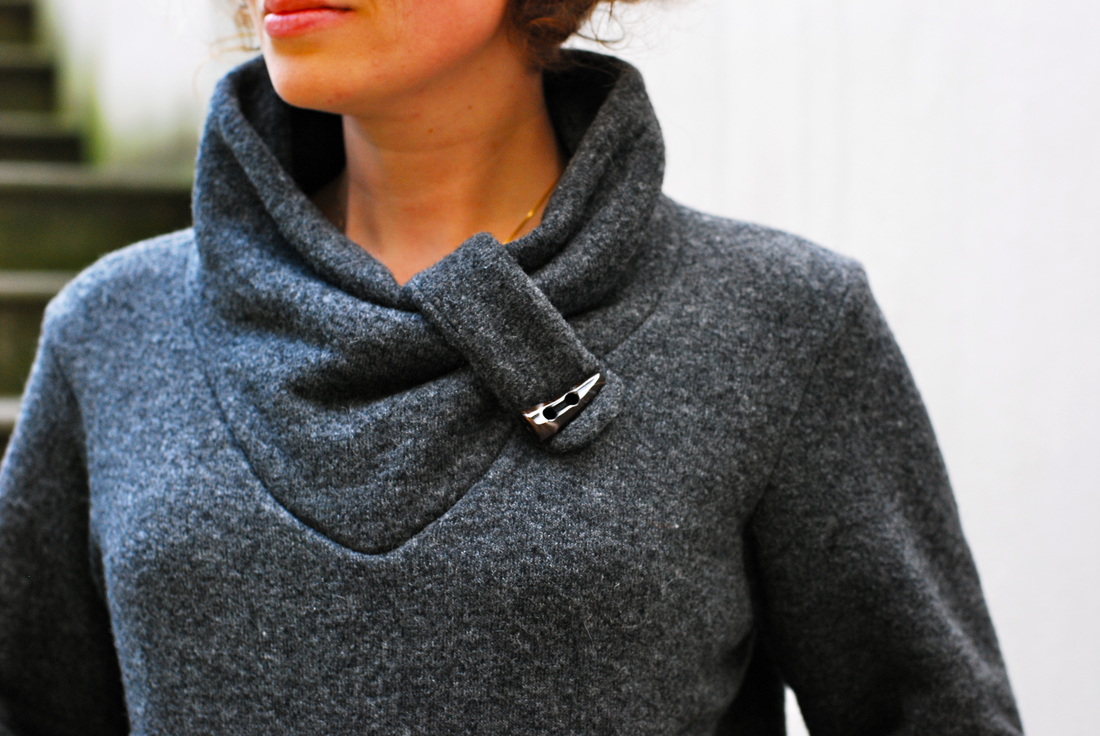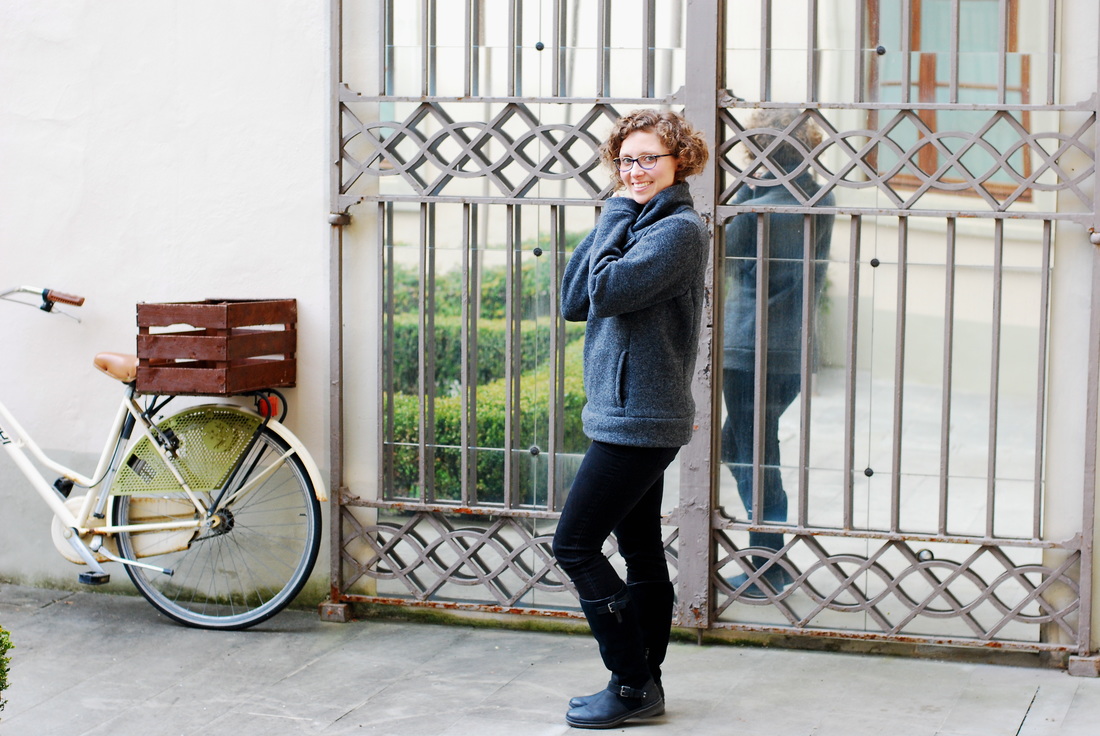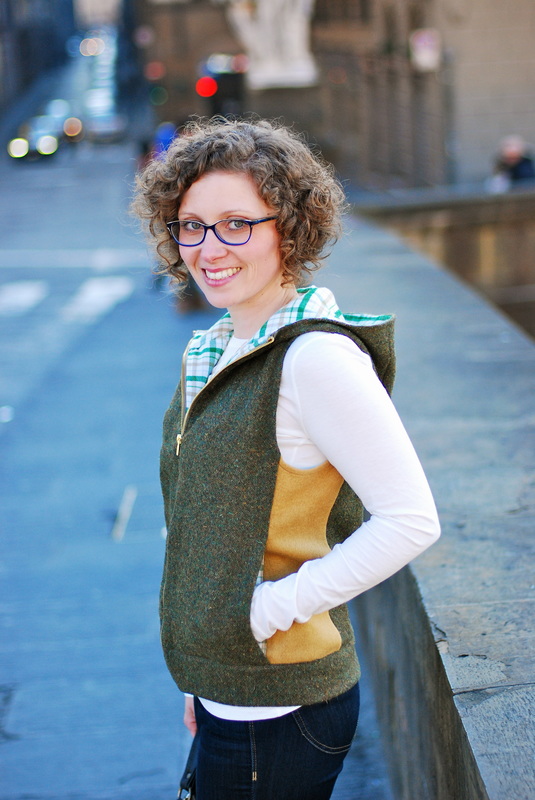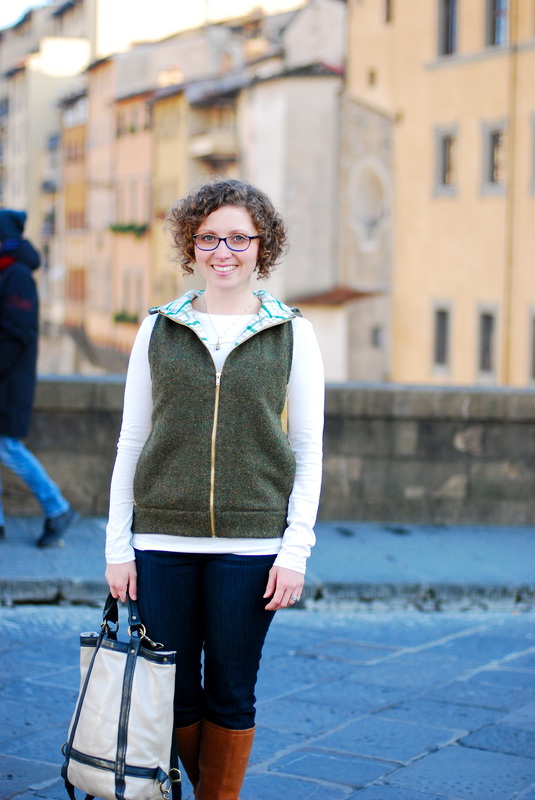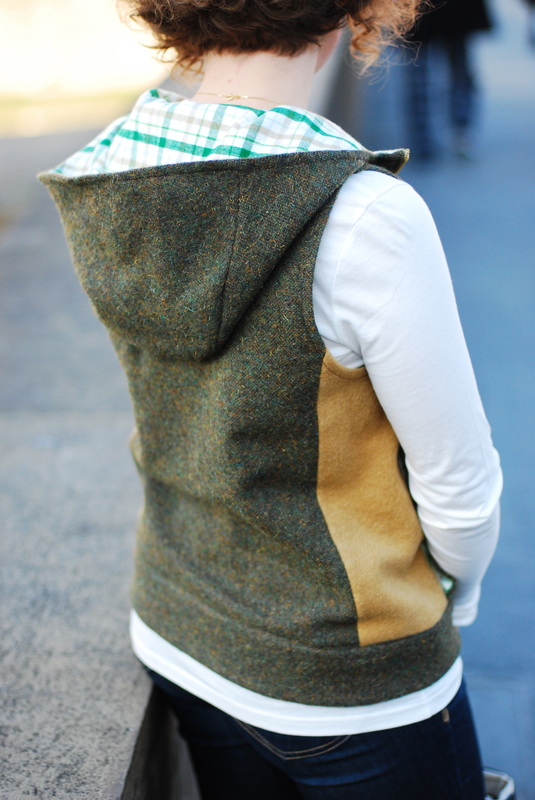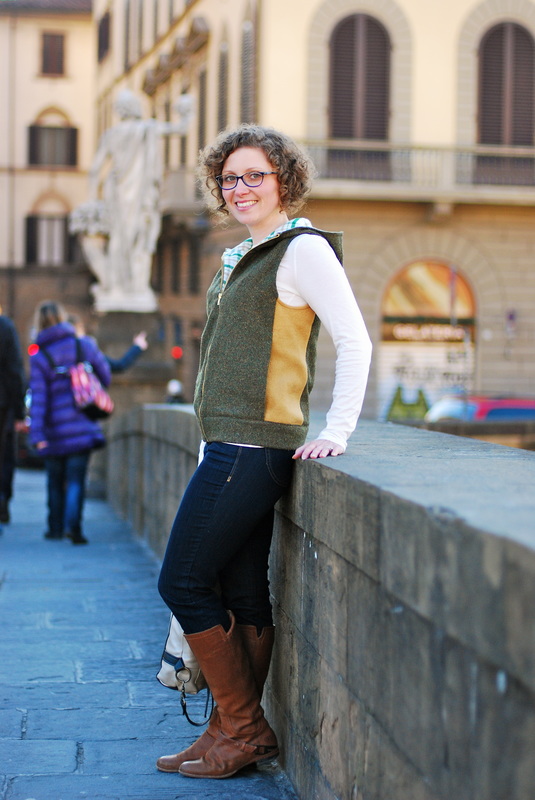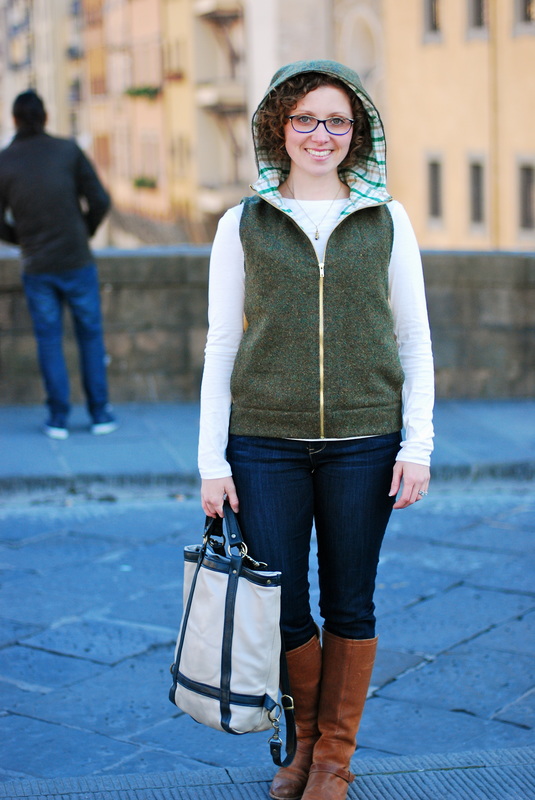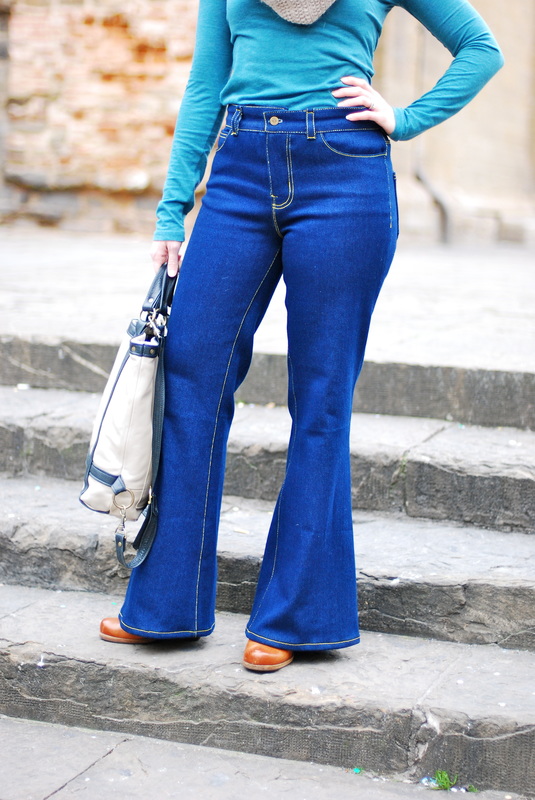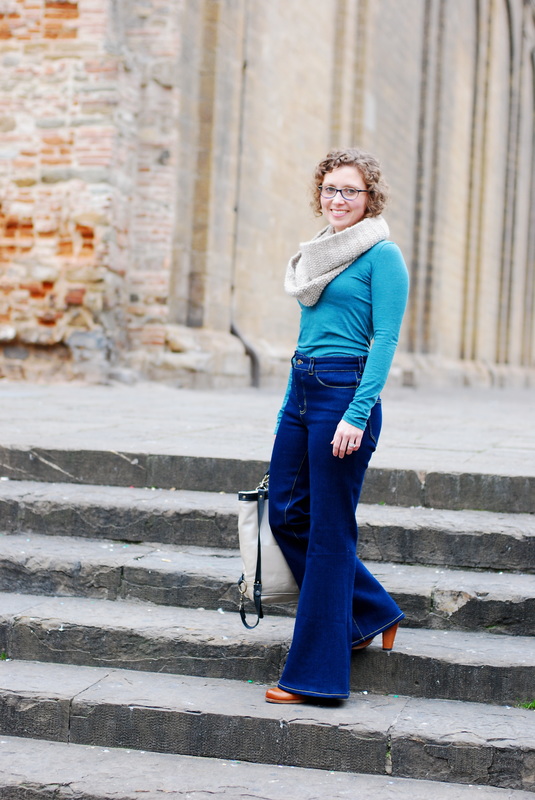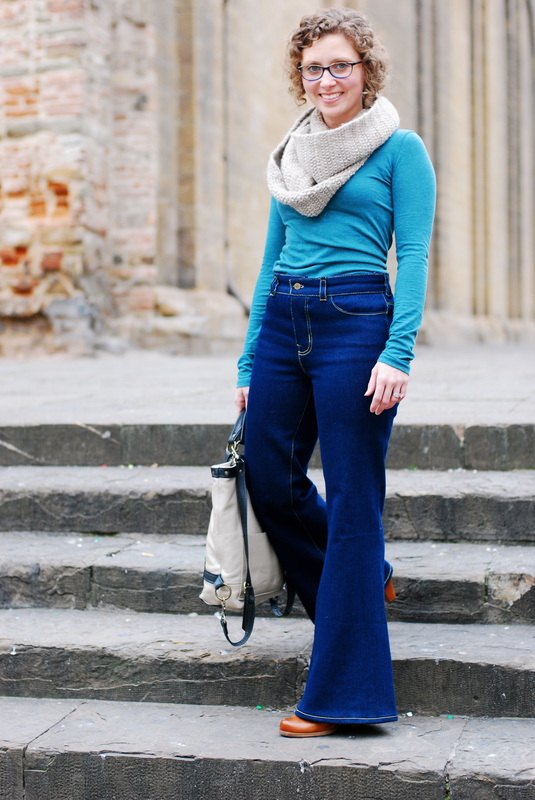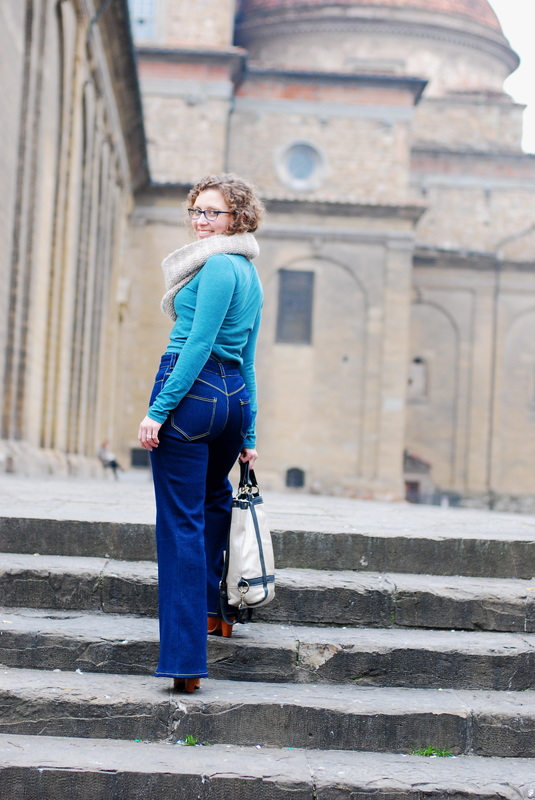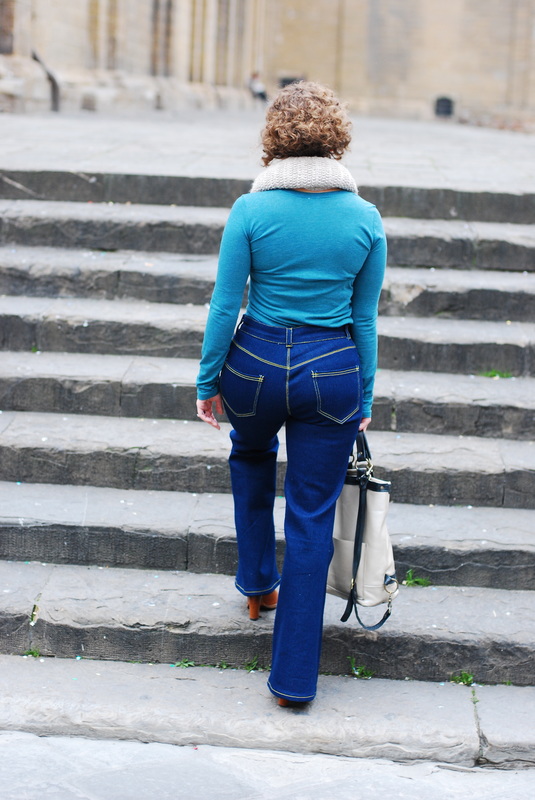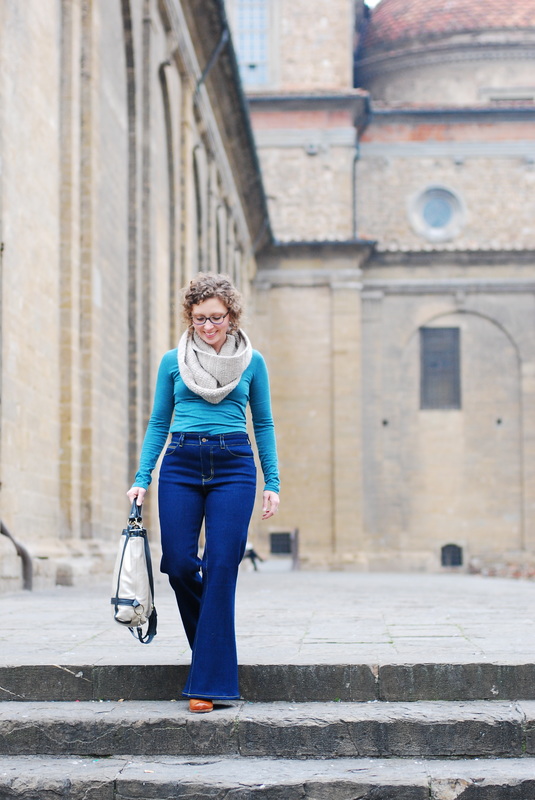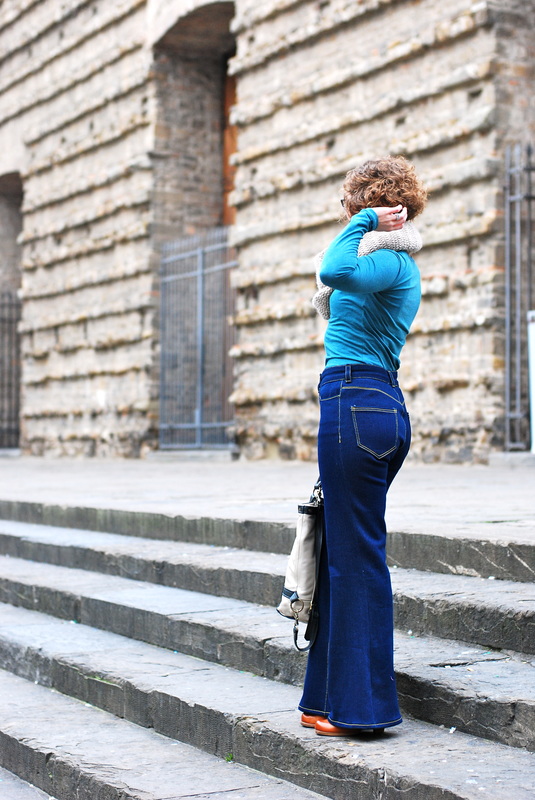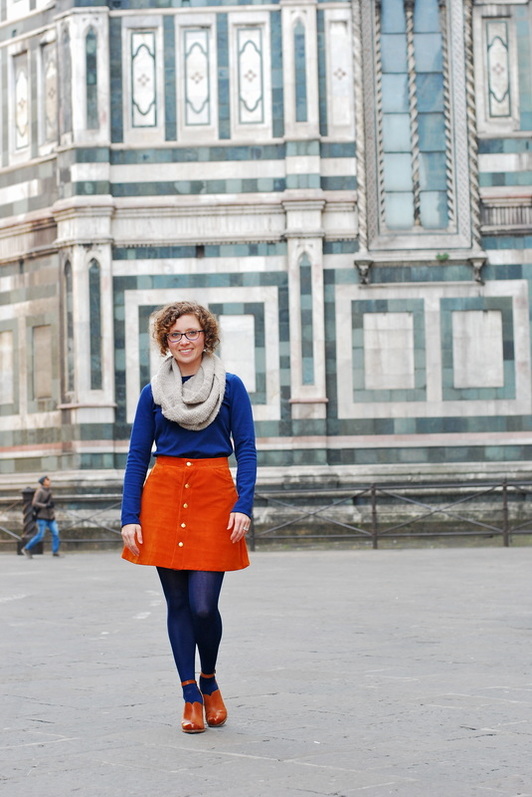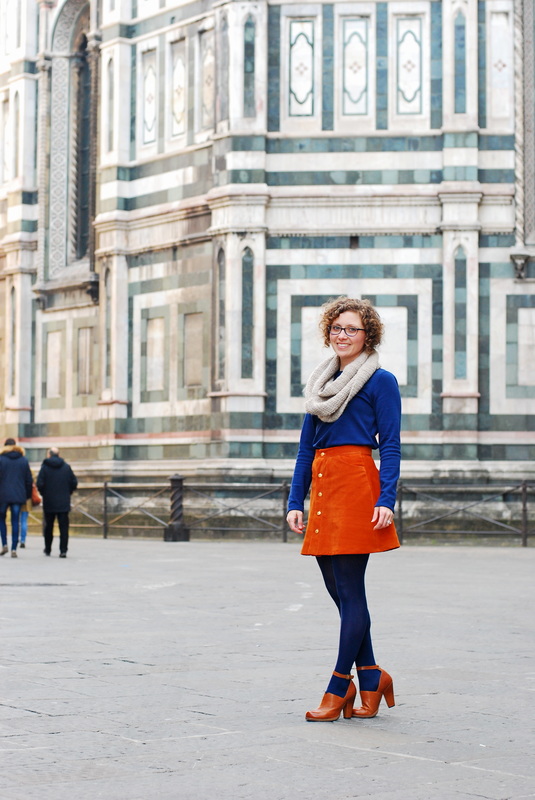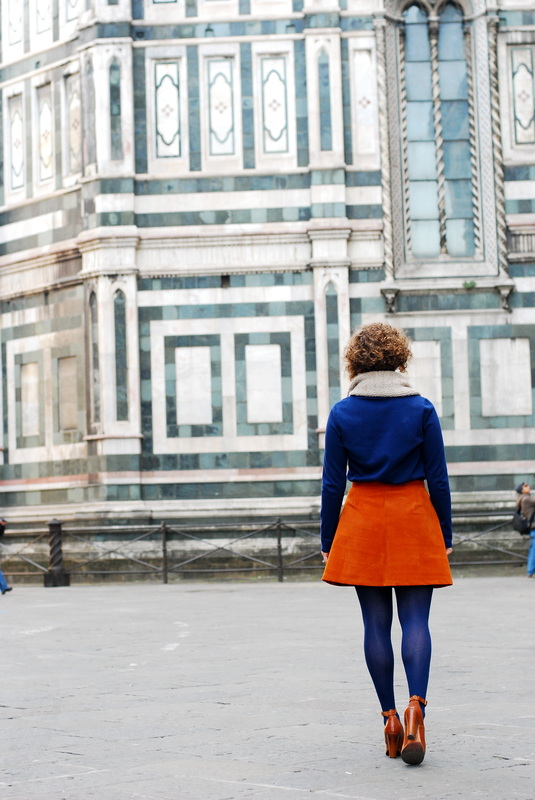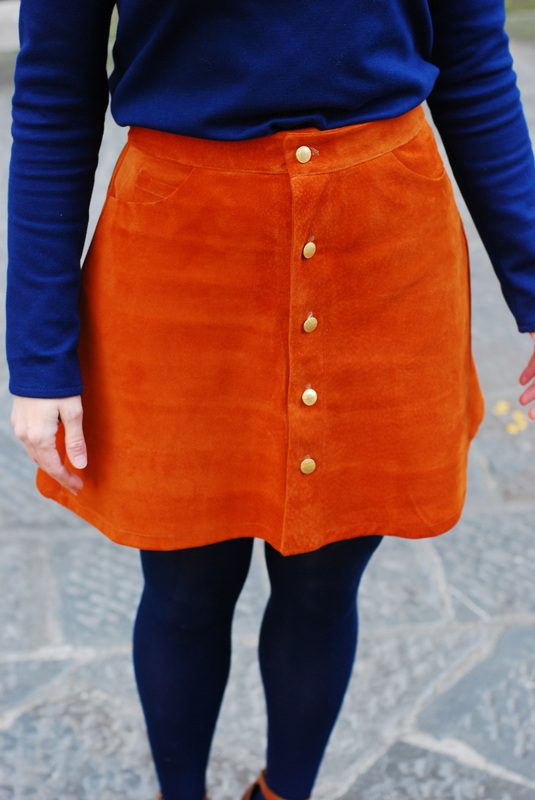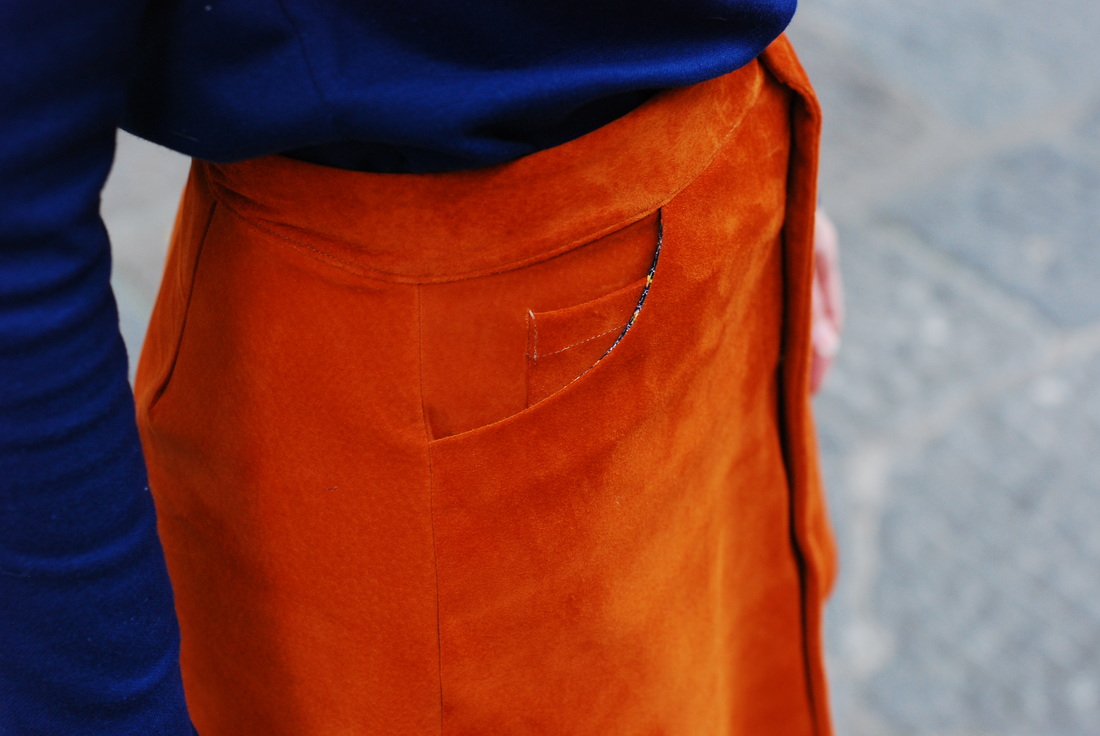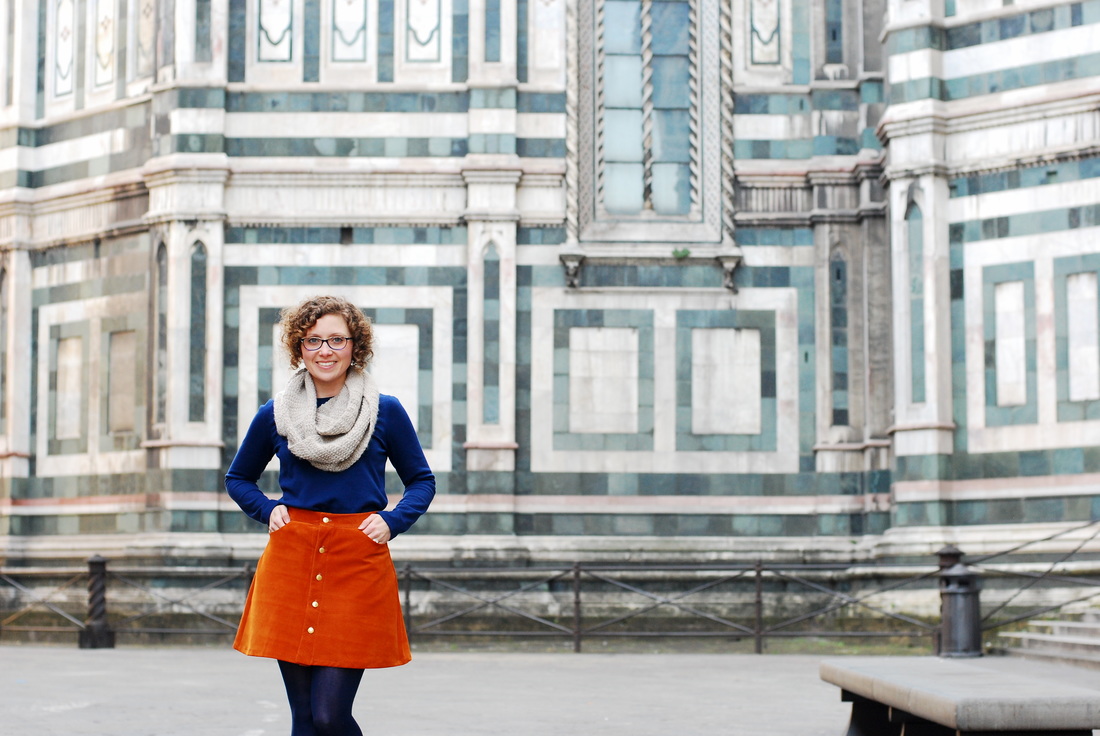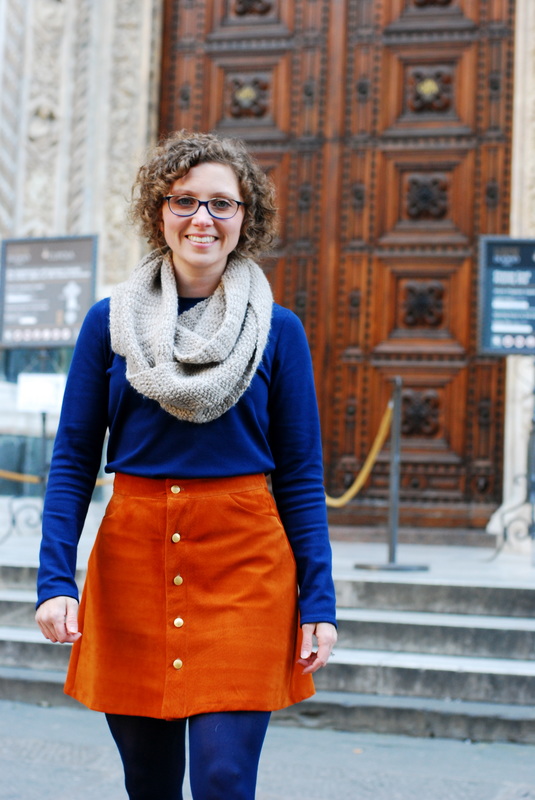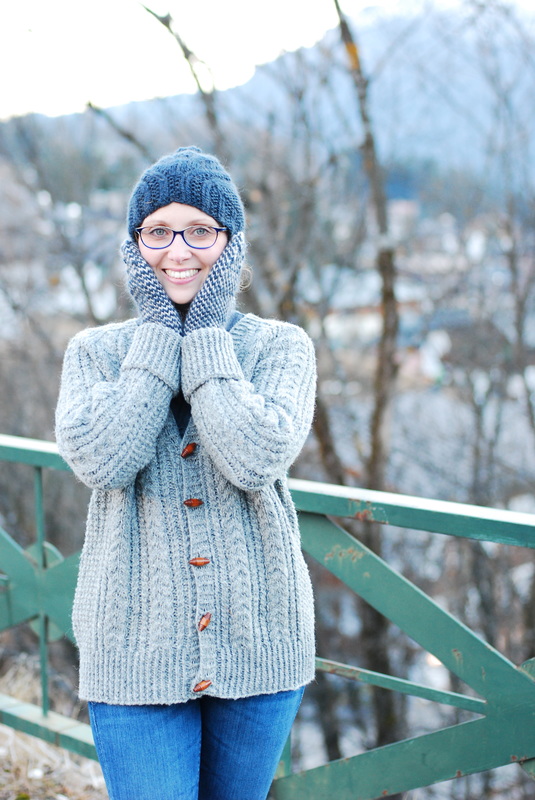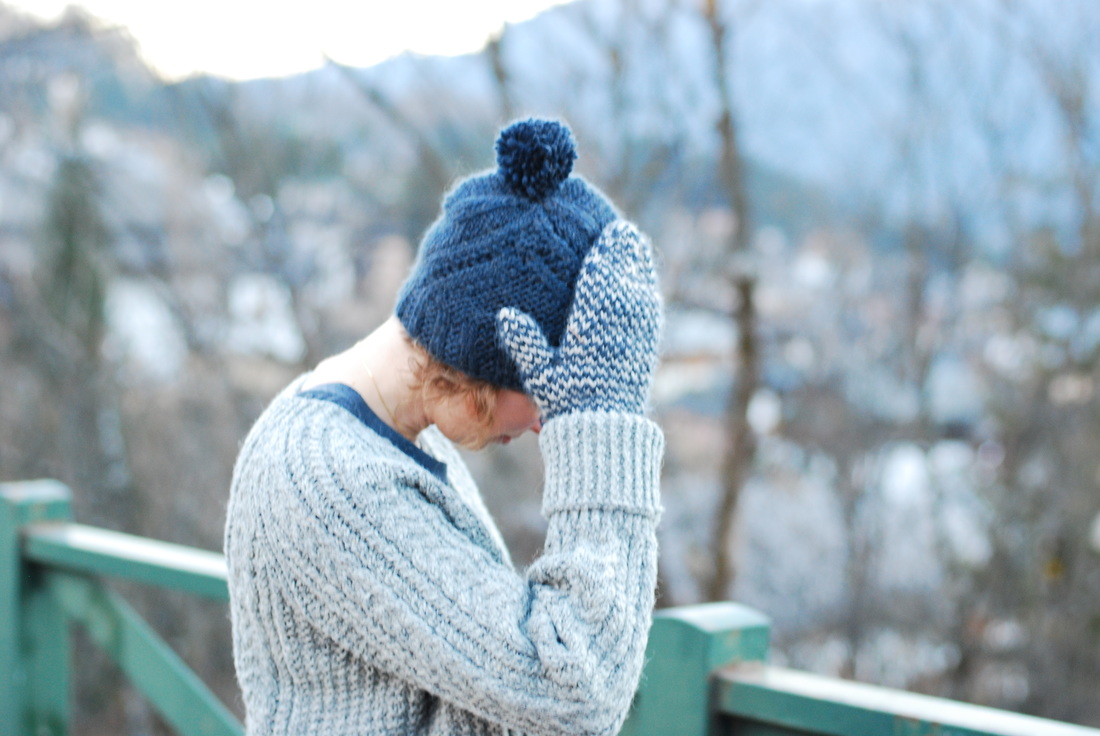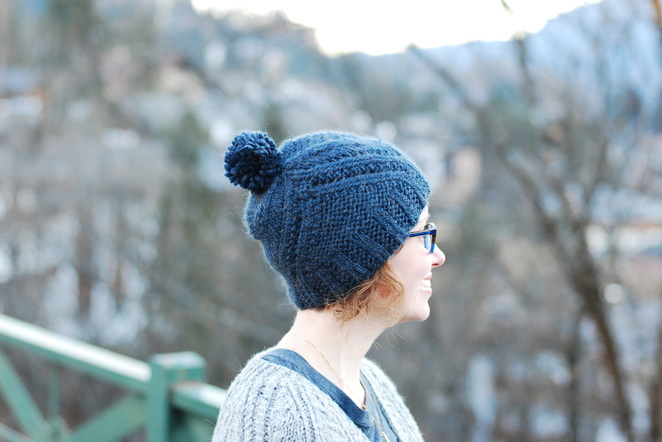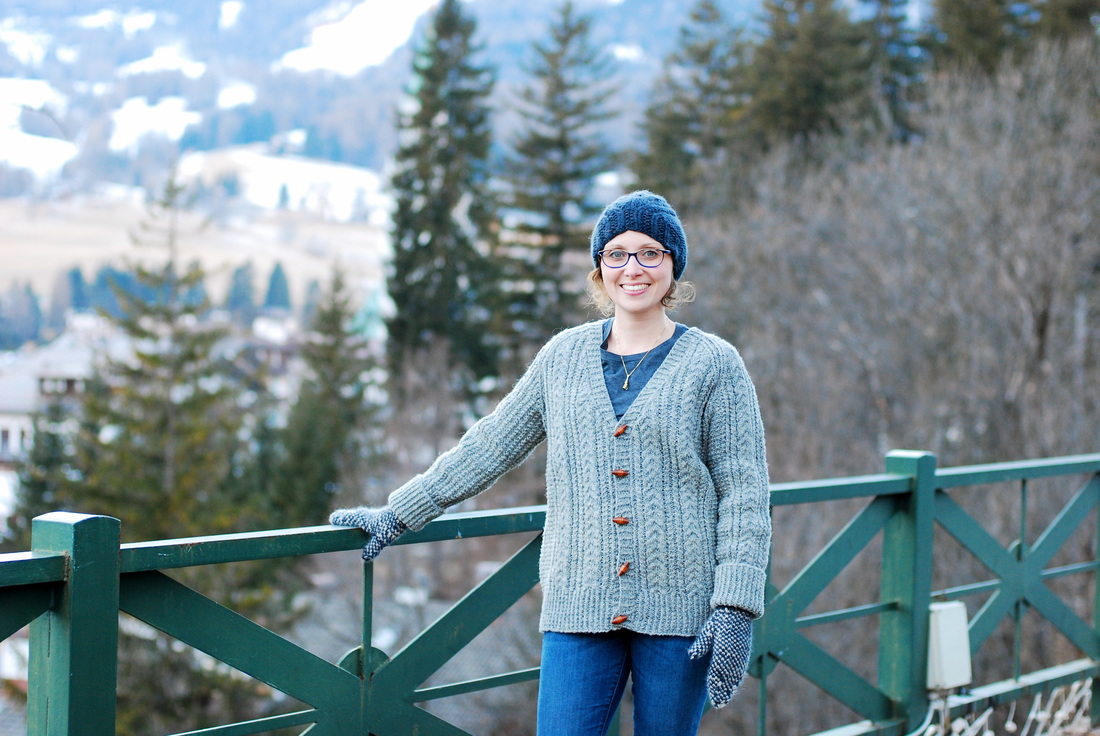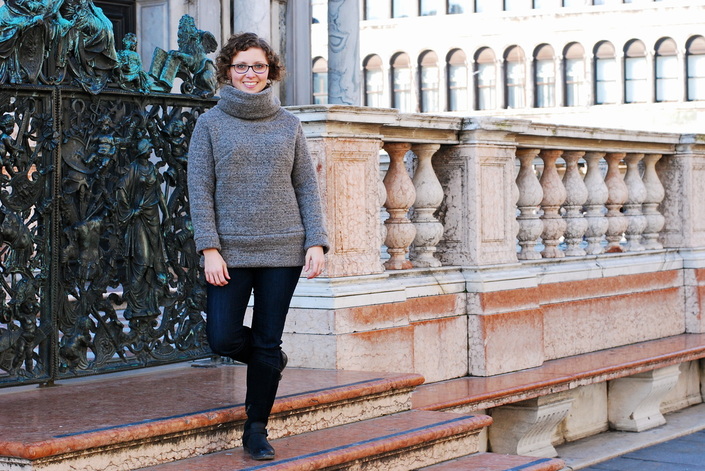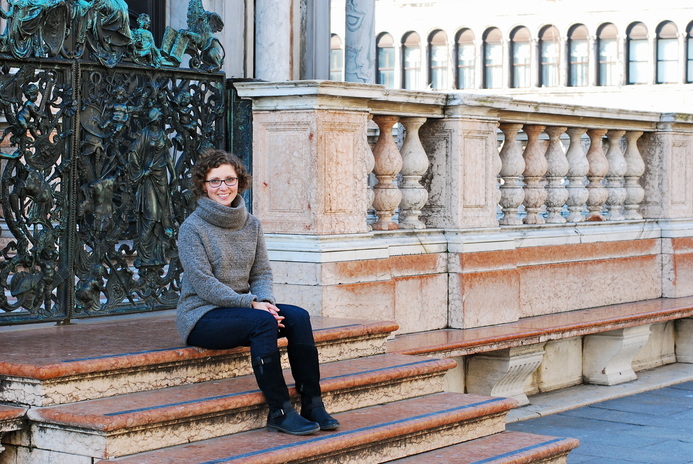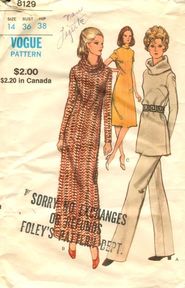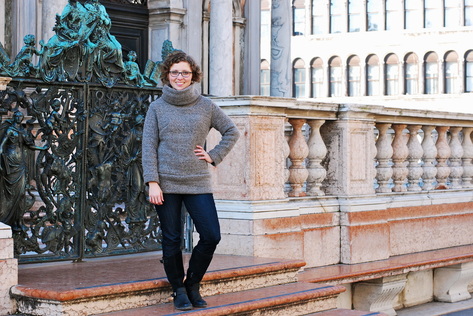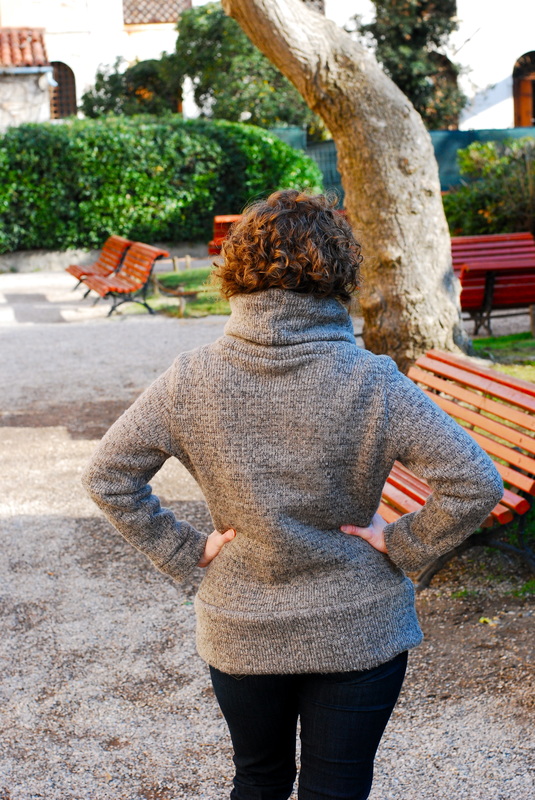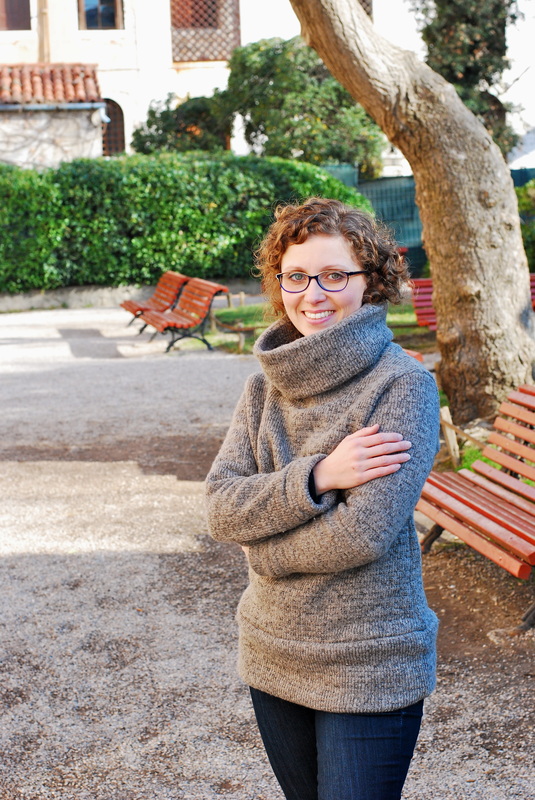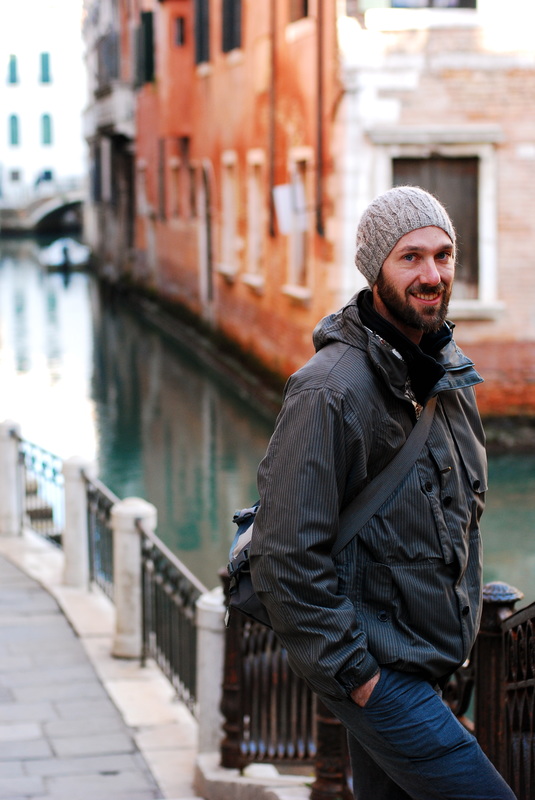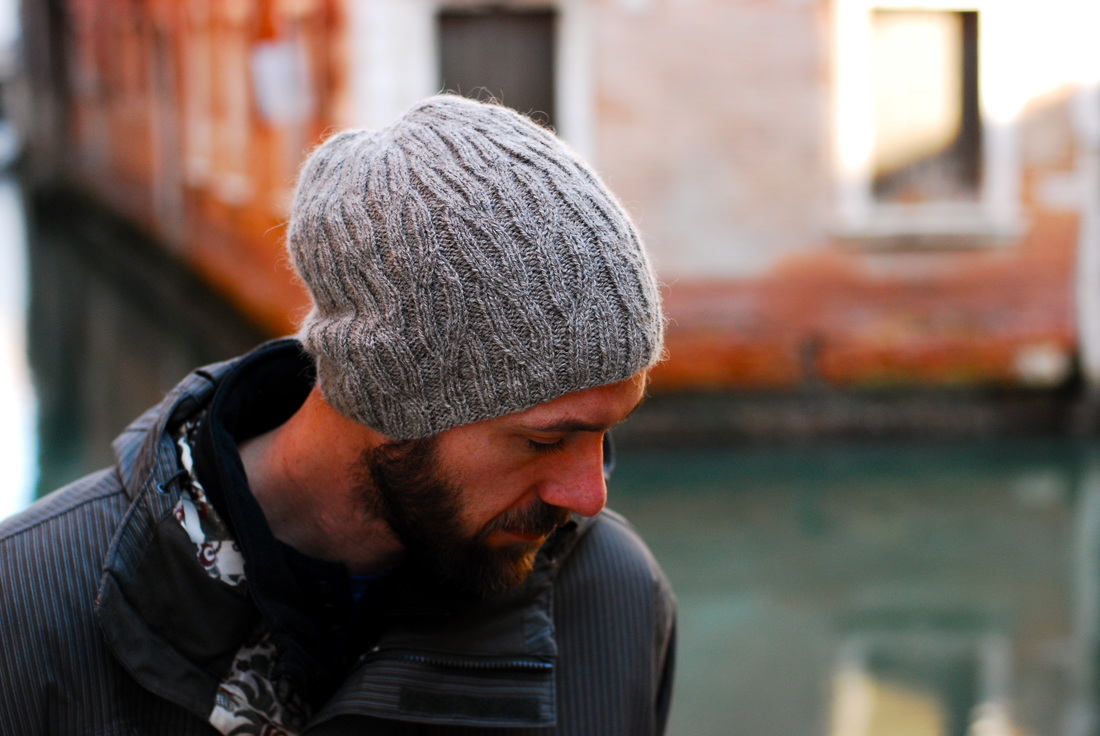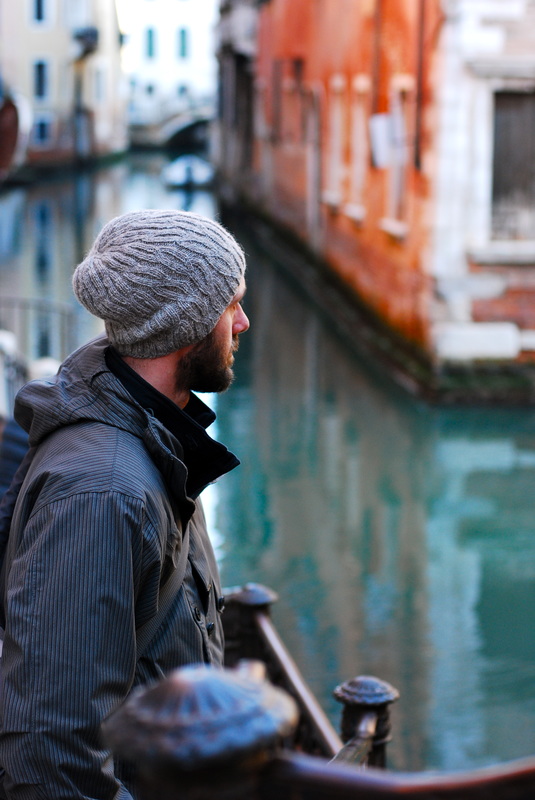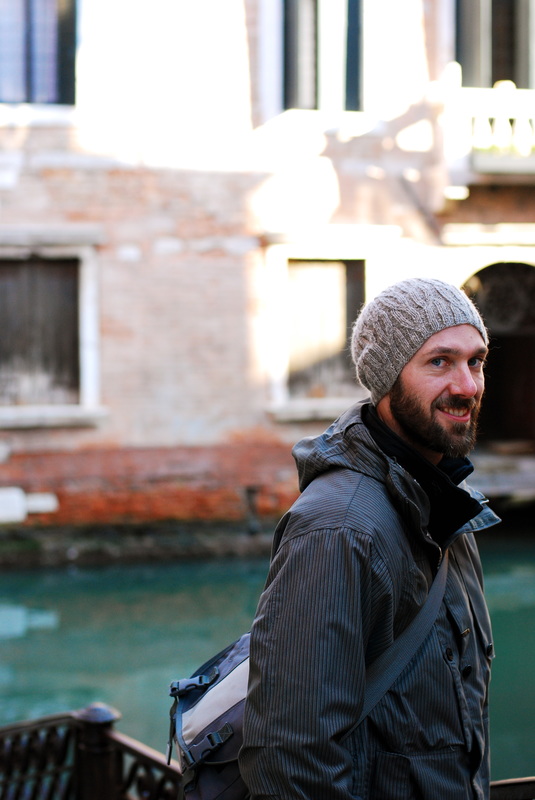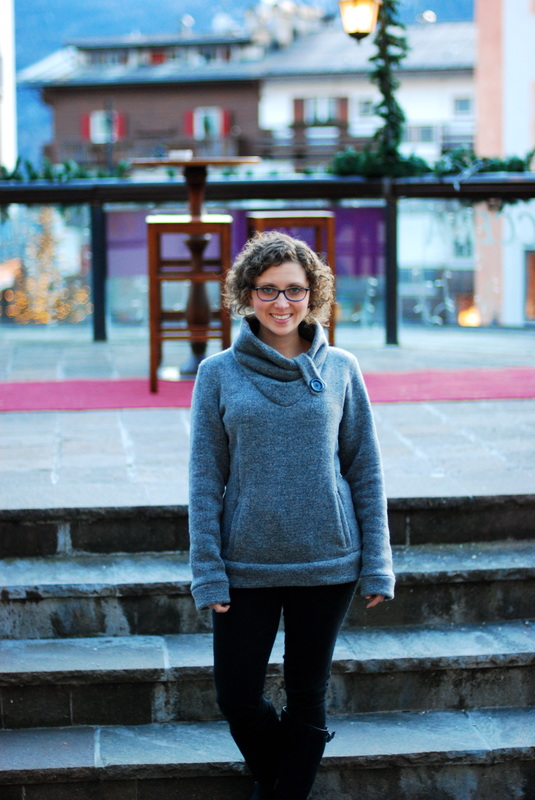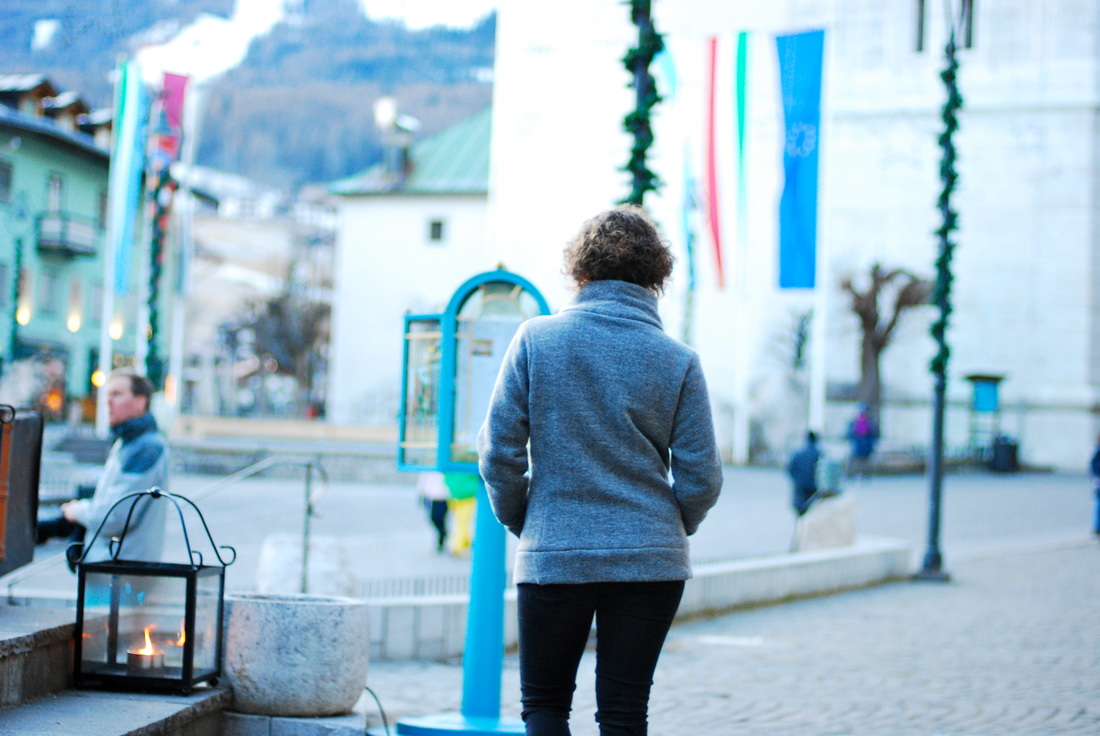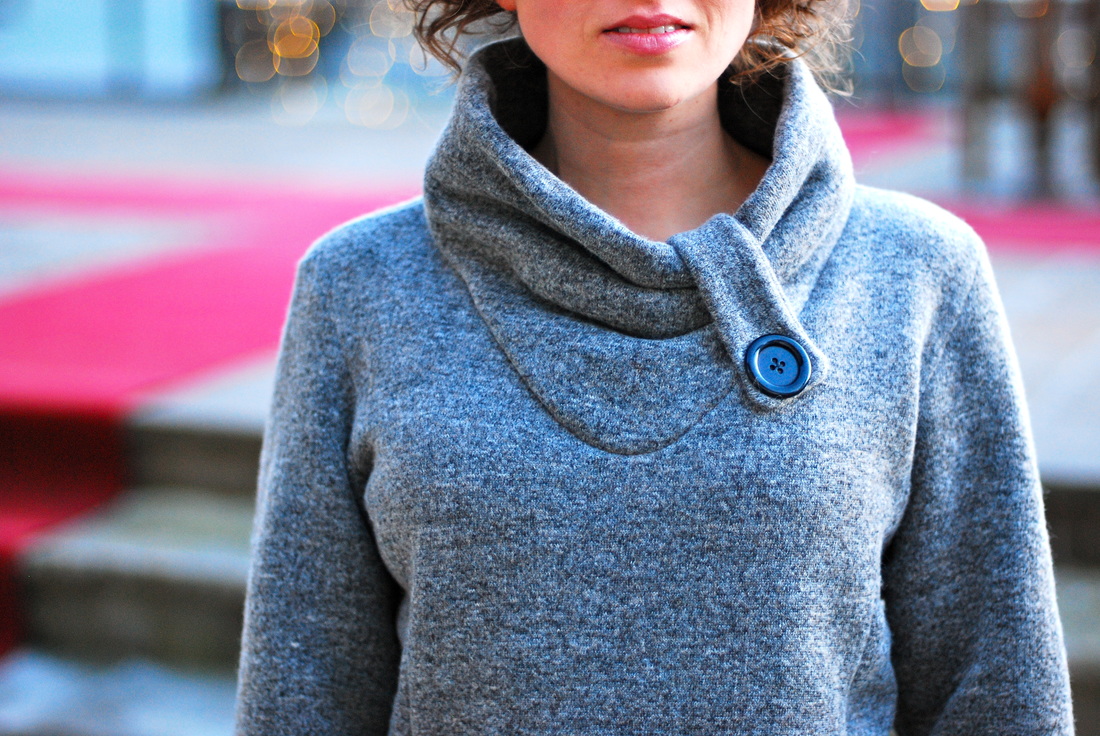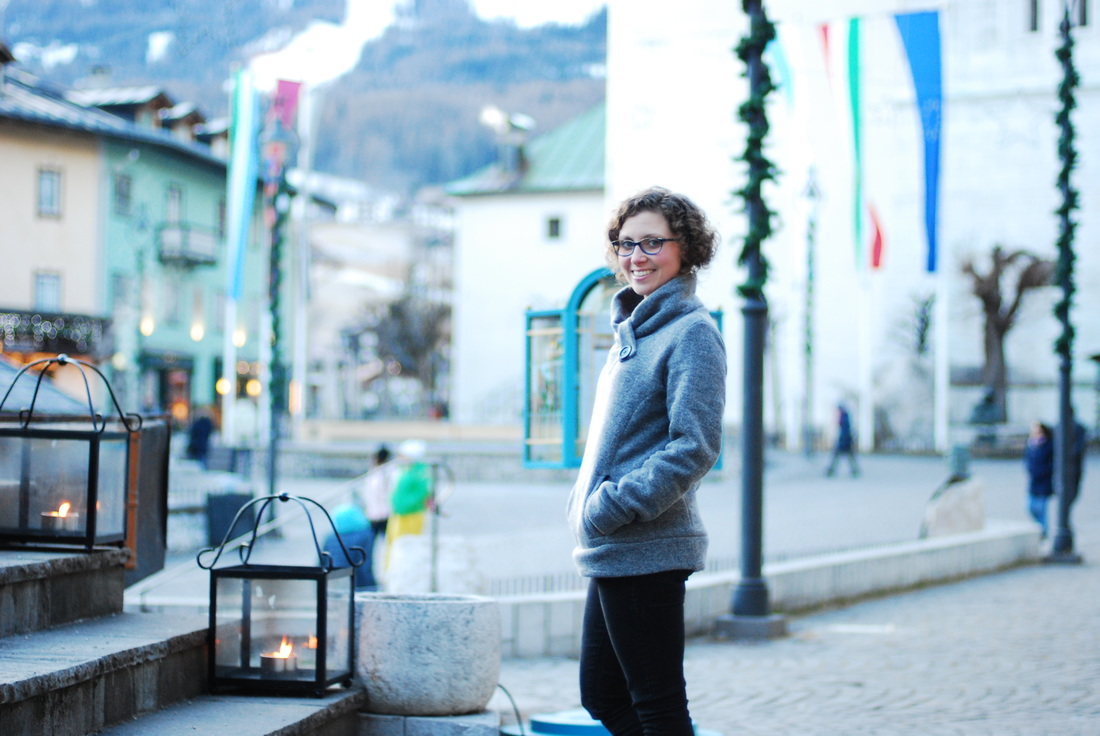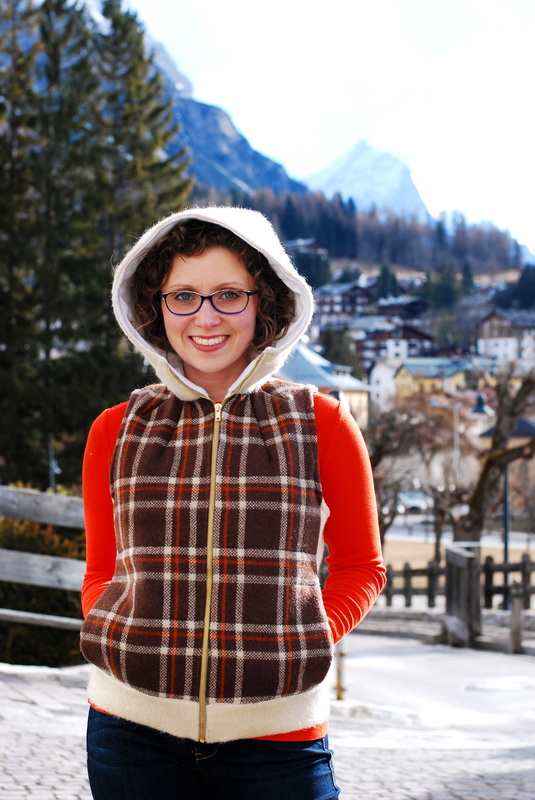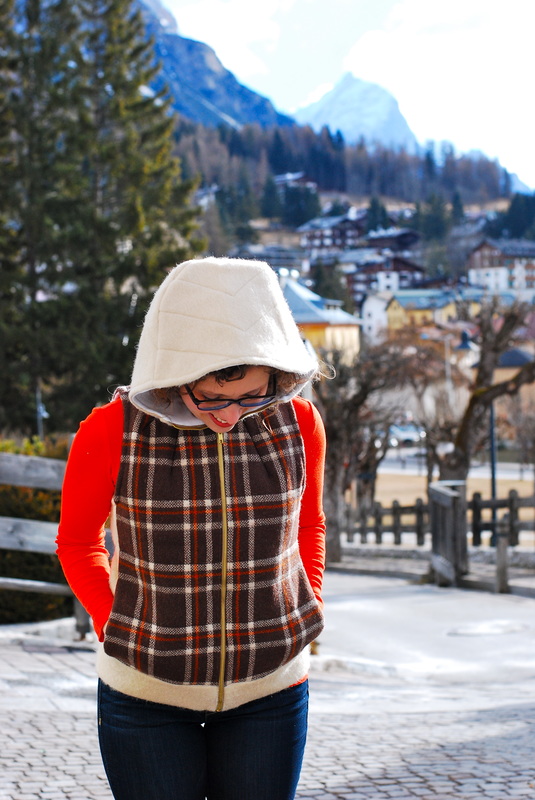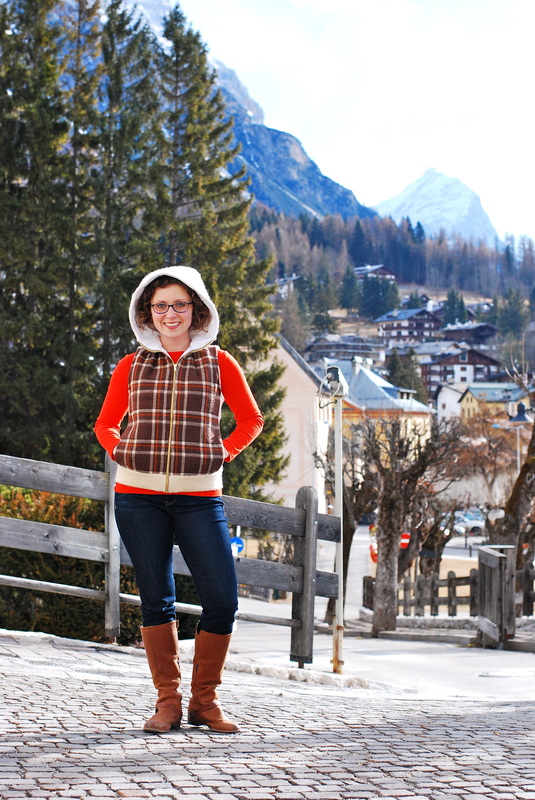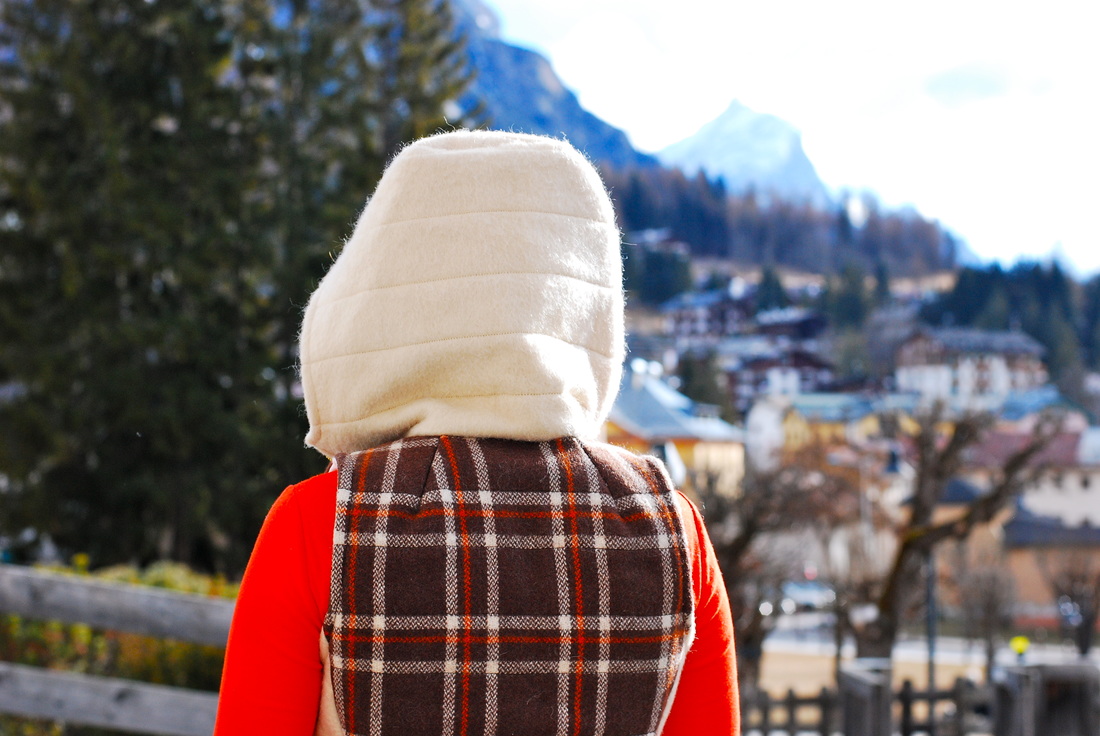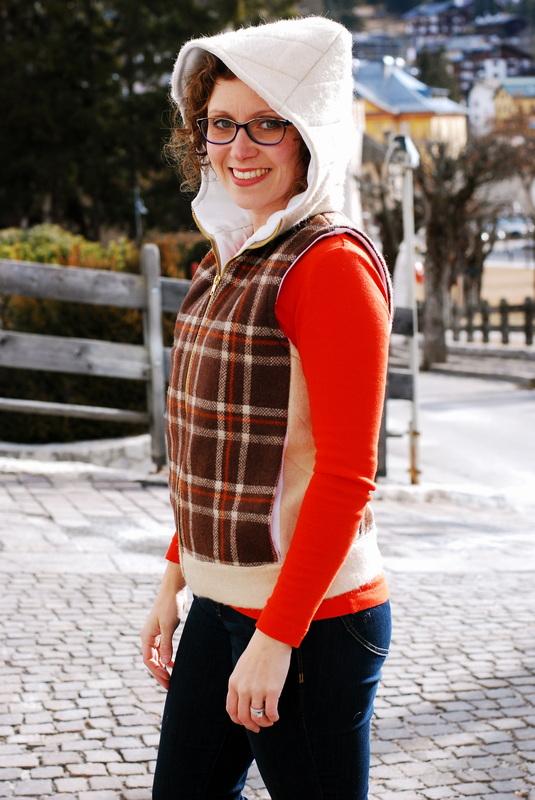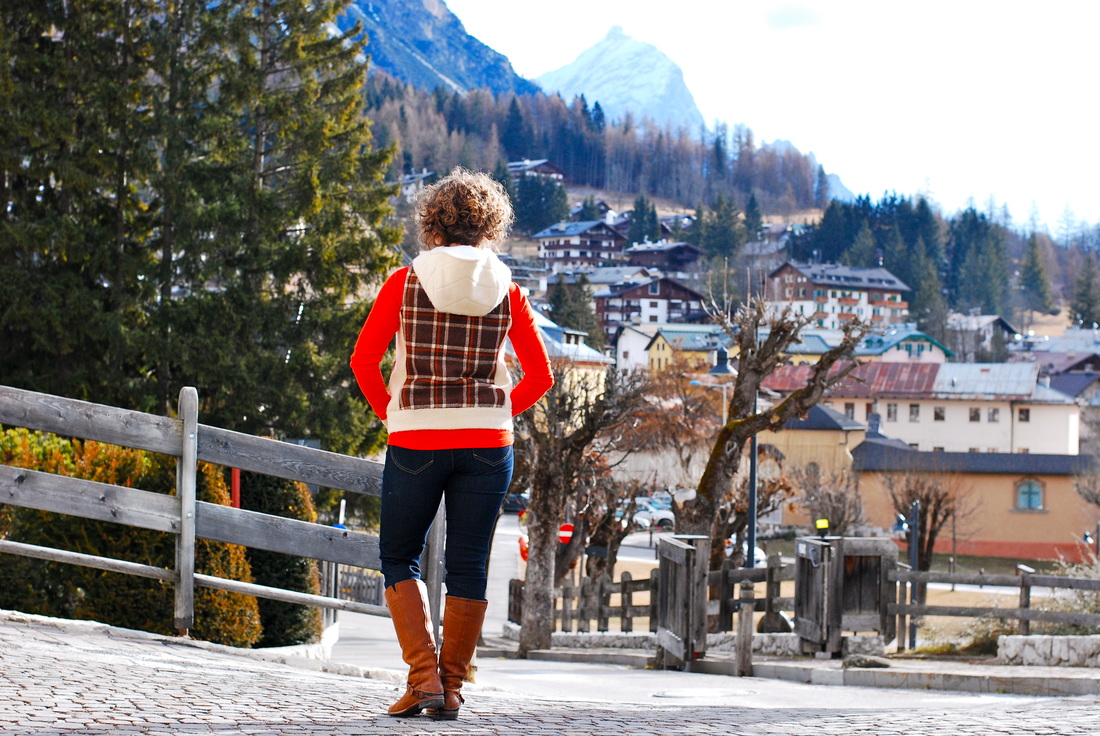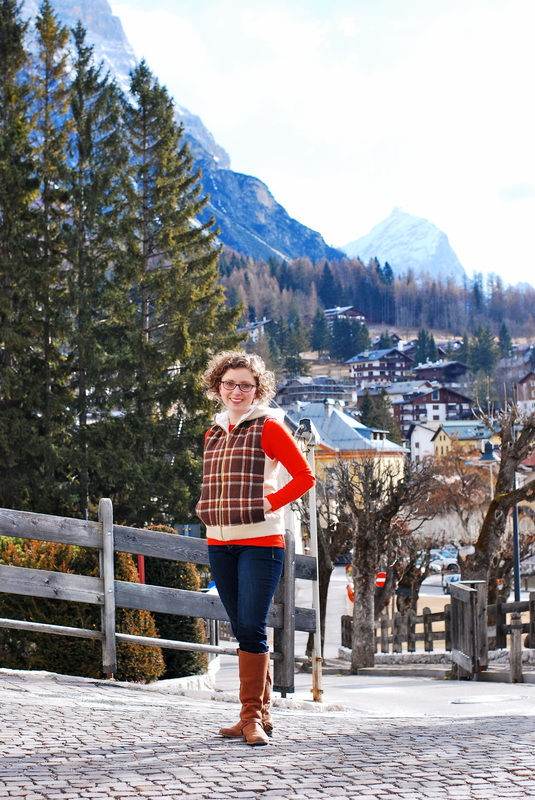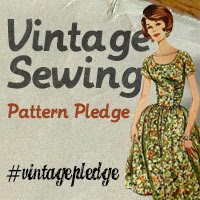|
The Jasper sweater is officially a winter wardrobe staple for this girl. This version is almost identical to the first Jasper I posted in this space, just a different shade of grey. I love this pattern sewn in boiled wool. The collar has more structure in wool than it does in the sweatshirt fleece fabric I used on a third rendition of this pattern. Three seems to be my number these days. HA. But, I have a feeling I'll revisit this pattern again in the future. When I do use this pattern next, I may try to bring the shoulders in a smidgen. I don't necessarily want the same should fit in a sweatshirt that I would want in a tailored garment, but I think that they could come in a touch. I don't have a lot to add regarding the pattern. It's got excellent features and design details. It's clearly written and has nice supporting tutorials on the Paprika Patterns website. As fun as it's been whipping through winter wardrobe additions, I'm hopeful that I'll be able to shift gears soon and concentrate on short sleeves and sundresses. :-D Oh, and JEANS. More. JEANS. Which patterns are on your radar for spring?
6 Comments
MORE WINTER CLOTHES. I don't know about you, but I'm full-on daydreaming about summer sewing. I'm tired of the darkness and the cold weather. Last week we were teased with temps in the high 50s, then we had a random snow and wind storm yesterday. Not cool, Mother Nature; not cool. I'm doing my best to keep cozy and cute wearing all the winter wardrobe projects I added to my closet this season. Today, I present Dropje Vest, round two, which happens to be my favorite of the three versions I made. I love sewing patterns more than once. Not only does it make the purchase of the pattern more worthwhile, it allows me to explore different possibilities with the garment I'm making. My first version of this pattern is decidedly outwear. It's quilted, interlined with batting and quite heavy. It will hold its own, especially during crisp fall weather. My second version is also warm; it's wool lined with flannel, but it's considerably lighter weight and more flexible than the first Dropje I made. It works both as a light jacket or layer and a wear all-day piece. In addition to the versatility that this version of Dropje offers, I really love my fabric choices on this vest. Both the wool fabrics are stash from estate sale purchases. The green is a tweed with shades of green, teal, and brown flecks. I have yardage of this remaining that I'd love to turn into some sort of blazer. The side panels are a vintage camel hair blend. I had less than a yard of it, and I am excited that I was able to use it. The flannel was leftover from an Archer I sewed during the fall. #SCRAPBUSTINGFTW All of these fabrics were purchased at separate times, but I couldn't have planned this combination any better. Being a fabric hoarder... I mean... having a stash to shop really paid off in this instance. LOL. Similar to my first version of the Dropje, I chose to fully line my vest and used inseam pockets in place of the patch pockets provided.
Have you started to shift gears and work on spring projects? In addition to buying this pattern directly, it's available on Indie Sew who just happened to release their spring lineup at the begining of the week. Bring on the sunshine. This project is my greatest sewing accomplishment to date! I sewed jeans! I still can't quite believe it. BLUE JEANS, you guys. I'm not sure why, but it feels like a big deal. This project made me feel like I'd leveled up in the same way sewing a dozen (+) Archers made me feel. Like, I'm not just some newb sitting at home tinkering with a sewing machine. I have been sewing for about five years now. My closet is predominantly filled with garments I've made. There is barely a day that I don't wear something I've sewn or knitted. But those things combined don't equal the level of achievement I felt upon finishing these jeans. And, it's silly, because they weren't actually difficult to make. Apparently, jeans were just a mental hurdle I needed to jump over. I finally built the courage to tackle this project after sitting on the sidelines watching other sewing bloggers try their hand at jeans making, (Heather, I'm looking at you!) These jeans are sewn from the Birkin Flares pattern by Lauren of Baste and Gather. They are a classic, five pocket, mid-rise, flared jean. I have nothing to compare this pattern to, in terms of past sewing projects, but I can tell you, there is A LOT I like about this pattern. First off, this pattern caught my attention during its testing phases. Pairs of these jeans were popping up all over my Instagram feed. I could hardly believe the number of people involved in the testing of these jeans. At the release of the pattern, a lot of tester photos were shared on Lauren's blog in two separate posts 1 & 2. A wide variety of heights and body types are represented in that tester group, which made it easier for me to imagine these jeans on my own body. And, to make things even better, a lot of those testers were directly available to comment on the pattern and the changes they made to their versions in the Baste and Gather facebook group. The group offered near instant feedback from people who had experience with the pattern. Pretty great. As far as the pattern is concerned, it is a layered pdf document, so you have the option to print a single size, if you choose. The instructions are clearly written and easy to follow. With regard to size, I decided to blend the rise of the size 26, the waist of the size 28, and the hip of the size 29. I also knew I needed to shorten the leg length, so I started by taking two inches from each of the lengthen/shorten lines. Then, I took an additional two inches from the hemline. (Six inches total). I wish I would have left one inch on the total length. The good news is that I'm wearing a four inch heel in these photos, so I can easily wear these jeans with a flatter shoe. The next time I make this pattern, I'm going to try removing the majority of the leg length from the lengthen/shorten line above the knee. I have some bagging at the back of my knee, and I think making that adjustment will help. My fabric for these jeans is an estate sale denim. It's got a nice amount of stretch to it, but I have no way to know exactly what the ratio of stretch is. I have my eyes peeled for stretch denim constantly now. I have a feeling I'm going to have to get a hold of some Cone Mills denim for future pairs. I can see another pair or two of Birkin Flares in my closet. Also, I'm waiting on the edge of my seat for the release of the add-on to this pattern, the Kendall Skinnies. I might try some other jeans patterns, but I'm pretty pleased with these and think they could be my go-to with a little bit of adjusting.
This is the type of skirt I would have been sent home for wearing in high school. Really. we had a dress code. There was kneeling and measuring involved (nothing shorter than 2" above the knee). It was altogether humiliating and awful. As long ago as that was, long hem lines have pretty much been permanently ingrained in my brain since. This skirt feels rebellious. And, I kinda like it. This skirt is the Rosari skirt from Pauline Alice. I immediately fell in love with its seventies vibe. When I saw her suede version, I nearly fell off my chair. I knew that I needed one. I've worked with leather before. I have three classes from Chicago School of Shoemaking and Leather Arts under my belt, and I felt confident that I could apply the skills I'd learned at home. I'm also fortunate to live about 20minutes away from a Tandy Store, so supplies were easy to come by. I chose sheepskin suede for my skirt. It's a thinner leather with more drape than some other hide varieties and it seemed like a nice garment weight. I knew that my machine would be able to handle sewing it, unlike some leathers that require an industrial grade machine to sew. There are some differences between sewing with fabric and leather. To start, there's no such thing as yardage. You buy hides. For this skirt I used two. Next, leather has no grain. You can place your pattern pieces very closely together and without regard to direction, just make sure you're avoiding blemishes and thin areas. You can really Tetris your pattern pieces together, which means there is less waste. There's no seam finishing, because there are no threads to unravel. Also, with leather, once it's punctured, the hole is permanent, so there's little room for error, and you will want to avoid pinning. During my projects at leather school, we glued our seams prior to sewing. I skipped this step at home, because I didn't have any glue handy, but I definitely intend to do this in the future, as I think it will be a huge benefit in the structure of the waistband and hem. There's also some differences in the tools you'll want to use on a project like this. You don't iron leather. To get crisp seams you hammer them open with a mallet. I used a rubber mallet and a block of wood. You could also use a wooden mallet. Whatever you decide, be careful not to hammer any indentations into your work. I was extra cautious and hammered over the top of a piece of scrap suede to make sure I minimized potential for marking. The most difficult areas to hammer out, I thought, were the darts. I don't have a firm, curved surface that could handle me beating on it, so they aren't quite as flat as I'd like. In these pictures, I'm wearing my Rosari with a Grainline Lark Tee. When this pattern was introduced, I was a little underwhelmed. It's a basic tee pattern. No bells. No whistles. BUT, I didn't have a solid tee pattern. I've sewn Renfrews before, and I like them well enough, but they don't fit the way my RTW tee shirts fit. That, I think, is the biggest difference between the Lark Tee and the Renfrew. The Lark tee looks and fits like the type of tee you might find at a major retailer. I sewed three Lark Tees in a row, because I was so pleased with the result. At some point, it might deserve its own post, but the versions I sewed for this trip are super basic and I think you can see what I'm talking about in these outfit pictures. As a final thought, I know leather is a highly contentious issue for a lot of people. I absolutely respect that it's not for everybody. It might surprise you to know that I eat a vegetarian diet; it's something I'm very passionate about. I also come from a long line of hunters, and I take no issue with the practice of hunting for food (trophy is another story). And, as part of that mentality, I believe that the best way to honor the sacrifice of an animal is to utilize it to the fullest, in a very Native American sacrifice/preservation sort of way... At any rate, I hope I haven't offended you, it's certainly not my intention.
Wool. Wool. Wool. And, more WOOL! What can I say, it's a winter wardrobe staple for this girl. This post is a heaping spoonful. Three projects of wondrous warmth at once! Let's start at the bottom and work our way up, shall we? This sweater is White Pines by Amy Christophers. This is my second White Pines. I've knit this pattern before (yeesh, has it really been five years?!), but this is the first time I've knit a sweater pattern twice. I've always been of the "too many patterns and too little time" mentality. I have more patterns favorited than I will ever be able to knit in my lifetime. However, my original White Pines has stood the test of time, as have most of my raw wool sweaters. Sure they're rough in the beginning. They're not as immediately appealing at their merino cousins. They are hardy workhorses, though. And, like wine, they get better with age. The more they're worn and washed, the more lovely the yarn becomes, and without all the pilling, to boot. So, back when I was bagging stash yarn into projects and came across this Reynolds worsted raw wool I'd purchased at an estate sale, it made sense to use it on a hardy, wear-over-everything cardigan. It also seemed silly to take a chance on a new pattern when I already had such a sweater in my closet. If it's not broken, don't fix it. This pattern produces a gorgeous, classic cardigan. It's a simple raglan design, and the cables make it fun to knit. I've knit the size 34 1/2", which gives me approximately 5" of positive ease from the finished dimensions. This sweater will definitely benefit from a nice soak, but I can already tell it's going to settle wonderfully. The mittens are knit using Ruth Anne's Mitten pattern. I decided to knit them after I'd settled on a hat pattern. I wanted my hat and mittens to coordinate, so I set-out in search for a bulky yarn mitten pattern. I love that these mittens are simple, but not boring. I also love that there are two strands of yarn throughout the mitten, giving them an extra layer of warmth. These are knit from estate sale yarns too. I had a couple skeins of Rowan Polar leftover from my Arvigen and some Elsebeth Lavold Chunky AL that worked great together. To top things off, I used the remaining skeins of Rowan Polar to knit the Fidra hat. This pattern was knee-jerk purchase for me. I knew I needed it as soon as I saw it released! Love at first sight. Phew. That's a whole lot of knitting at once. But, let's face, it there's no such thing as too much yarn, right?
We had a very brief excursion to Venice during our trip. It was too brief, actually. Still, Mike and I made our way around as large a portion of the city as we could. With all its canals, winding streets, and beautiful architecture, Venice is remarkable. However, it also felt like a giant tourist trap. Once you get off the ferry, you're captive. It's impossible to walk ten feet without encountering a Murano glass gift shop and/or a gondolier. We tried our best to propel ourselves around the city in search of gelato and coffee. We like to do this sort of thing when we travel. We pick a food and/or a drink that the place is known to do well and experience as much variety of that thing as we're able. In Brussels, it was chocolate and frites. Paris, macarons. Ireland, cider... you get the gist. It helps give us some direction with our wandering. Unfortunately, a lot of the top rated gelatarias were closed for winter holiday. Fortunately, we still found a few. We had a particularly amazing scoop of chocolate pistachio at SUSO. The pistachio was a little bit salty and the consistency of a nut butter. It was perfect mixed into the chocolate and possibly my favorite flavor I tried the entire trip. In between brain freezes and coffee breaks we bounced between landmarks on our way to... FABRIC (of course). As a side note, if you're like us and prefer to explore new places on foot, National Geographic is an excellent resource for pre-fab walking tours. For Venice there were several options to choose from, but we mainly stuck with the Rialto area in order to maximize the time we had available. It was crisp and cool while we walked around, but I stayed comfortable in another garment sewn from a wool sweater knit. This fabric is bulky and squishy. When I bought it, I imagined it would be perfect as a cozy sweater dress. That was my plan, actually. And, using vintage Vogue 8129, I sewed myself the ugliest, most shapeless dress imaginable. It was a disaster. The only redeemable feature was the collar. The collar on this pattern is magnificent and huge. I have a giant dome (trust me on this), and it looks small in comparison to the size of this cowl. Also, I really love this fabric, and I didn't want to feel like I'd wasted it. Rescue operations immediately commenced. I cut twelve inches from the length of the dress. I narrowed the side seams by inches. Then, I used the length I'd removed, folded it in half and turned it into a bottom band. In the end, this is not the most flattering garment I've ever sewn, but It's still pretty great and very wearable. Also, it's delightfully warm and cozy. My biggest complaint with this, as it stands, is that the seams are bulkier than I'd prefer. I do wonder if some sort of top-stiching finish like THIS might help them to behave better. Working with new types of fabrics always involves a new set of obstacles and a learning curve for me. If you have any tips on sewing with bulky knits, I'm very grateful to hear them! Before I sign off, CHEERS to a new year of #vintagepledge! Are you signed up to participate? I have some very loose goals for 2016, but vintage is always on my list of things to do!
Mike didn't get the same wardrobe enhancement I did prior to leaving for our trip. He did manage to cut out a couple patterns; I just didn't have time to put them together for him. He had to settle for a hat. But, a mighty fine hat at that! I've been trying to knit Mike a new hat each year. He's always cold, so he wears hats often (and quite well, I think). I know I like to have options when I'm accessorizing, so I figure he might too. I haven't quite been able to convince him that any of those options should be outside his standard earth tone color palate. Not yet. Maybe I'll surprise him with a red hat next time and test the boundaries of his comfort zone. This hat was knit using the Dembow written by Susan Dittrich. It's a really solid hat design featuring a faux cable looking stitch pattern. The whole pattern is charted out through the end of the crown decreases, which I really like. I can't be bothered with too many maths while I'm knitting. And, it's a FREEBIE! So, that's exciting. I could possibly have gotten away with one fewer pattern repeat. My hat turned out a little longer than the pictures on the pattern page. Mike likes it slouchy like it is. So, we're not going to mess with it. I can certainly see using this pattern again for future husband hats.
Is there anything quite like the comfort of a sweatshirt on a cold winter's day? There was a point in my life when I basically lived in over-sized sweatpants and hooded sweatshirts (with flip flops, of course). There was also a point when this became completely inappropriate attire for my day-to-day situation. Now, with the rise of fashionable active wear companies, there are lots of 'elevated' ways to wear sweats without looking like you just rolled out of bed. Pattern companies spotted this trend early on, and there are SO MANY different pattern options available for those of us who would rather sew our own than shop! The first sweatshirt pattern to catch my eye is the Jasper Sweater by Paprika Patterns. I especially LOVE the striped version shown on the pattern page. (If anyone can tell me where I can get my hands on some striped sweatshirt fleece, I'll be forever indebted!). In particular, the things that drew me to this pattern are the deep cowl neck with button tab, the single welt kangaroo pocket , and the side panels that help provide some fit/shape to a traditionally shapeless sort of garment. Knowing that I wanted to push my sweatshirt into that spectrum of elevated active wear, I decided to up my fabric game and used a boiled wool knit fabric instead of sweatshirt fleece. I'm so pleased I did! The resulting garment is a fusion of two of the coziest things a girl could wear in the winter rolled into one. It was exactly what I wanted to be wearing after a day on the slopes! I've sewn a few of these too. I couldn't resist! I feel no shame in admitting that I already have another sweatshirt pattern on my radar; SewingLikeMad 's two versions of the Halifax Hoodie made it easy to rationalize additional sweatshirt sewing. Past, sweatpants wearing Michelle would be so proud.
Historically, most of my sewing energy has been directed at warm weather. I love sewing dresses and skirts, and I wear them often when I can. But, they're not enough to get me through the year. It gets cold in Illinois. VERY cold. If I wanted to continue working towards my goal of a completely self-stitched closet, I needed some winter wear. Pronto. Knowing that I had our Cortina trip approaching was an excellent catalyst towards filling some of my wardrobe gaps, because I had a suspicion the Dolomites would be a great place to take pictures of my cold weather creations. To get started, I made a list of the types of clothing I reach for when the temperature drops. Layers are key for transitions between indoor and outdoor settings, so clothing that's easy to put on and comfortable to wear over the top of other garments was high on my list. Right around the time I started making a list of the types of projects I wanted to sew, I saw the Waffle Patterns Dropje on IndieSew. I had gone searching for a similar vest patterns weeks prior to this pattern release, so I took it as a sign from the expanses of the universe that we were meant to be together. If there was any doubt in my mind that I needed this pattern, seeing Lauren's Pendleton version pushed me over the edge! I love the possibilities for customization with this vest. My goal for this version was to sew a "puffy" vest, that would be suitable for use as outerwear. To do that, I knew that I wanted to use batting and include some quilting lines to keep things in place. I also decided to fully line the vest and create in-seam pocket bags instead of patch pockets. I had fun with the quilting and chose a few different line directions to stitch varying pieces of the vest: chevrons on the top of the hood, horizontal lines down the fronts and backs of the body, and diagonal lines on the sides. This was the first thing I've ever quilted, so I played it by ear and used a tip I'd read online (painter's tape) to mark my stitching lines. I think it turned out pretty good! I have a collection of small pieces of wool that I purchased from a milliner's estate and I was really excited to find I could use some of them on this pattern. The pattern calls for 2meters of 55" wide fabric, but I'm certain I had less than a yard each of my main and contrast fabrics. Spoiler alert, I made more than one of these. The shape of the vest is less fitted than I'm used to, but it's perfect for layering. It's warm too. MISSION ACCOMPLISHED!
|
Archives
March 2017
|
